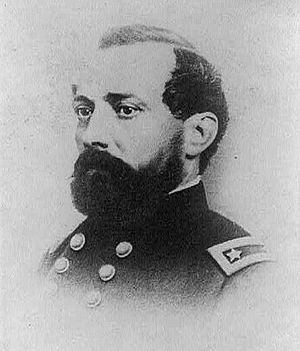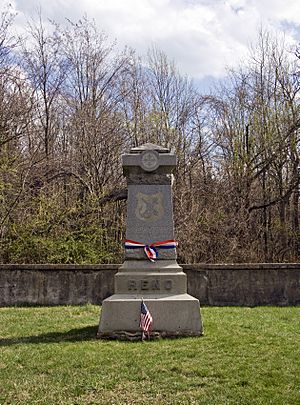Jesse L. Reno facts for kids
Quick facts for kids
Jesse L. Reno
|
|
|---|---|

Jesse Lee Reno
|
|
| Born | April 20, 1823 Wheeling, Virginia (now West Virginia) |
| Died | September 14, 1862 (aged 39) near Boonsboro, Maryland |
| Place of burial |
Oak Hill Cemetery (Washington, D.C.)
|
| Allegiance | United States Union |
| Service/ |
United States Army Union Army |
| Years of service | 1846–1862 |
| Rank | |
| Commands held | Mount Vernon Arsenal, IX Corps |
| Battles/wars | Mexican–American War American Civil War |
Jesse Lee Reno (born April 20, 1823 – died September 14, 1862) was a brave United States Army officer. He fought in the Mexican–American War and later became a Union General during the American Civil War. People called him a "soldier's soldier" because he always fought right alongside his men. He sadly died in battle during the Civil War. Many places, like Reno, Nevada, and Reno County, Kansas, are named after him.
Contents
Early Life and Education
Jesse Reno was born in Wheeling, Virginia (which is now West Virginia). He was one of eight children. His family's last name used to be "Renault" but they changed it to "Reno" when they came to America from France in 1770.
In 1830, his family moved to the Franklin, Pennsylvania area, where Jesse spent his childhood. He was accepted into the United States Military Academy in 1842. He was a very good student and graduated eighth in his class in 1846.
At West Point, Jesse Reno became close friends with Stonewall Jackson, who would later become a famous Confederate general. Other friends and classmates included George B. McClellan and George Pickett.
Jesse Reno married Mary Cross Reno on November 1, 1853. They had five children together. One of their sons, Jesse W. Reno, later became famous for inventing the first working escalator!
Fighting in the Mexican-American War
In 1847, during the Mexican–American War, Jesse Reno was an artillery commander. He fought under General Winfield Scott in several important battles in Mexico. He showed great bravery during the Siege of Vera Cruz and the Battle of Cerro Gordo.
He was also very brave during the Battle for Mexico City and the Battle of Chapultepec. In this battle, he was seriously hurt while leading a howitzer battery (a type of cannon). Because of his courage, he received special honors twice during the war.
After the war, Reno worked in different places. He taught mathematics at West Point and helped create new training systems for heavy artillery. In 1853, he was promoted to first lieutenant. He also worked on a road survey in Minnesota.
Later, he was assigned to the Frankford Arsenal near Philadelphia. In 1857, he joined an expedition to the Utah Territory as the chief of ordnance (in charge of weapons and ammunition).
The Civil War Years
When Jesse Reno returned from Utah in 1859, he was promoted to captain. He then took command of the Mount Vernon Arsenal in Alabama. On January 4, 1861, he had to surrender the arsenal to Alabama troops. This happened without any fighting, as ordered by Alabama's governor. Alabama left the Union a week later.
After leaving Alabama, Reno was made a brigadier general in the fall of 1861. He moved to Virginia and began organizing five regiments of soldiers. His brigade fought in Maj. Gen. Ambrose Burnside's North Carolina Expedition from February to July 1862.
Reno then became a division commander in the IX Corps, which was part of the Army of the Potomac. During the Northern Virginia Campaign, he fought against his old friend from West Point, Stonewall Jackson, in battles like the Second Battle of Bull Run.
On August 20, 1862, Jesse Reno was promoted to major general. In September, he took command of the IX Corps.
The Battle of South Mountain
Jesse Reno was known as a "soldier's soldier" because he often fought right alongside his troops. He didn't always carry a sword or wear clear signs of his rank.
On September 12, 1862, Reno's IX Corps marched with the Army of the Potomac. They were chasing the Confederate army during the Maryland Campaign. On September 14, during the Battle of South Mountain, Reno was scouting the enemy's forces at Fox's Gap. He was shot in the chest.
He was carried on a stretcher to a command post. He told his friend, General Samuel D. Sturgis, "Hallo, Sam, I'm dead!" Sturgis thought he was joking, but Reno repeated, "Yes, yes, I'm dead—good-by!" He died just a few minutes later.
His Legacy Today

Jesse Reno's body was first taken to Boston, where his wife lived. Later, his remains were buried in Oak Hill Cemetery in Washington, D.C.
In 1889, a memorial was built by veterans of the IX Corps at Fox's Gap to mark where he died. This spot is now part of the South Mountain State Battlefield Park.
Many places across the United States are named after General Jesse Reno. These include the cities of Reno, Nevada, Reno, Ohio, El Reno, Oklahoma, and Reno, Pennsylvania. Both Reno, Nevada, and El Reno, Oklahoma, have monuments to him in their downtown areas.
The United States Army also named three outposts after him:
- Fort Pennsylvania in Washington, D.C., was renamed Fort Reno in 1862.
- Fort Reno was built near present-day El Reno, Oklahoma in 1874.
- The third Fort Reno was built in Wyoming in 1865.
Reno County, Kansas is also named in his honor. The Jesse Reno School in Washington, D.C., was named after him, but it closed in 1950.

